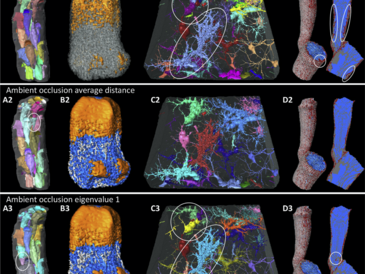J.Titschack, D. Baum, K. Matsuyama, K. Boos,C. Färber,W.-A. Kahl,K. Ehrig, D. Meinel,C. Soriano,S.R. Stock
Computers & Geosciences (2018) 115, 75-87
https://doi.org/10.1016/j.cageo.2018.03.007
During the last decades, X-ray (micro-)computed tomography has gained increasing attention for the description of porous skeletal and shell structures of various organism groups. However, their quantitative analysis is often hampered by the difficulty to discriminate cavities and pores within the object from the surrounding region.
Herein, we test the ambient occlusion (AO) algorithm and newly implemented optimisations for the segmentation of cavities (implemented in the software Amira). The segmentation accuracy is evaluated as a function of (i) changes in the ray length input variable, and (ii) the usage of AO (scalar) field and other AO-derived (scalar) fields. The results clearly indicate that the AO field itself outperforms all other AO-derived fields in terms of segmentation accuracy and robustness against variations in the ray length input variable. The newly implemented optimisations improved the AO field-based segmentation only slightly, while the segmentations based on the AO-derived fields improved considerably.
Additionally, we evaluated the potential of the AO field and AO-derived fields for the separation and classification of cavities as well as skeletal structures by comparing them with commonly used distance-map-based segmentations. For this, we tested the zooid separation within a bryozoan colony, the stereom classification of an ophiuroid tooth, the separation of bioerosion traces within a marble block and the calice (central cavity)-pore separation within a dendrophyllid coral. The obtained results clearly indicate that the ideal input field depends on the three-dimensional morphology of the object of interest. The segmentations based on the AO-derived fields often provided cavity separations and skeleton classifications that were superior to or impossible to obtain with commonly used distance-map-based segmentations. The combined usage of various AO-derived fields by supervised or unsupervised segmentation algorithms might provide a promising target for future research to further improve the results for this kind of high-end data segmentation and classification. Furthermore, the application of the developed segmentation algorithm is not restricted to X-ray (micro-)computed tomographic data but may potentially be useful for the segmentation of 3D volume data from other sources.


